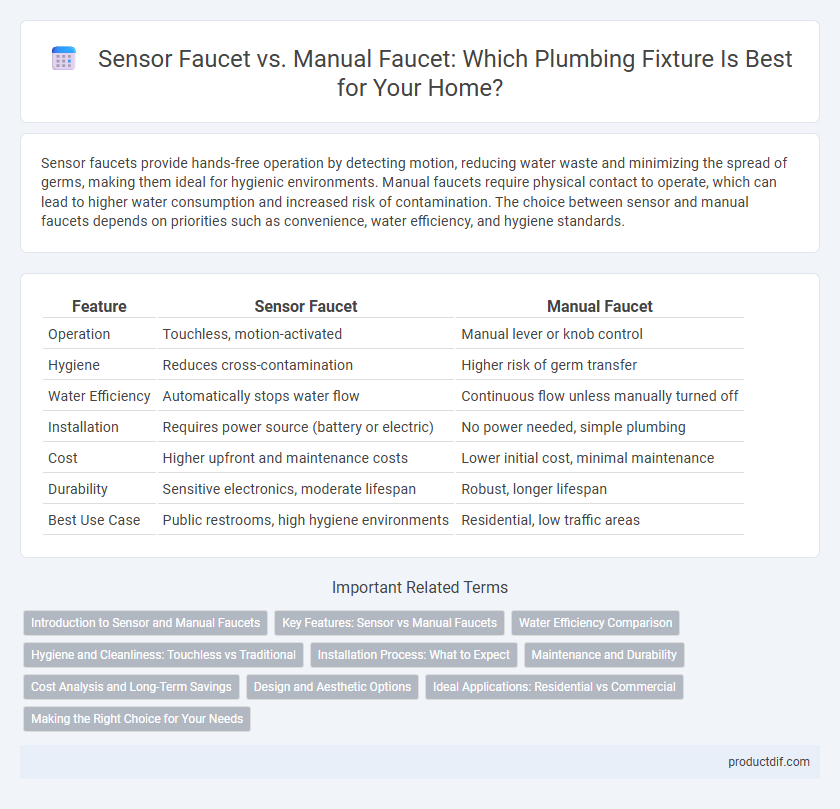Sensor faucets provide hands-free operation by detecting motion, reducing water waste and minimizing the spread of germs, making them ideal for hygienic environments. Manual faucets require physical contact to operate, which can lead to higher water consumption and increased risk of contamination. The choice between sensor and manual faucets depends on priorities such as convenience, water efficiency, and hygiene standards.
Table of Comparison
| Feature | Sensor Faucet | Manual Faucet |
|---|---|---|
| Operation | Touchless, motion-activated | Manual lever or knob control |
| Hygiene | Reduces cross-contamination | Higher risk of germ transfer |
| Water Efficiency | Automatically stops water flow | Continuous flow unless manually turned off |
| Installation | Requires power source (battery or electric) | No power needed, simple plumbing |
| Cost | Higher upfront and maintenance costs | Lower initial cost, minimal maintenance |
| Durability | Sensitive electronics, moderate lifespan | Robust, longer lifespan |
| Best Use Case | Public restrooms, high hygiene environments | Residential, low traffic areas |
Introduction to Sensor and Manual Faucets
Sensor faucets use infrared technology to detect hand movement, enabling touchless water flow and promoting hygiene by reducing contact with surfaces. Manual faucets require physical operation through handles or levers to control water flow and temperature, offering straightforward functionality and reliability. Both types serve essential roles in plumbing fixtures, with sensor faucets favored in public and high-traffic areas and manual faucets common in residential settings.
Key Features: Sensor vs Manual Faucets
Sensor faucets utilize infrared or motion detection technology to automatically control water flow, enhancing hygiene and conserving water by activating only when hands are detected. Manual faucets require physical operation via handles or knobs, offering straightforward control but increased risk of contamination and often higher water usage. Sensor faucets typically feature touchless activation, adjustable sensor range, and automatic shutoff timers, while manual faucets prioritize simplicity and mechanical reliability.
Water Efficiency Comparison
Sensor faucets significantly reduce water consumption by automatically shutting off flow when not in use, cutting water waste by up to 70% compared to manual faucets. Manual faucets rely on user control, often resulting in prolonged flow and unnecessary water usage. Studies show sensor faucets can save thousands of gallons annually in high-traffic areas, making them a highly efficient choice for water conservation.
Hygiene and Cleanliness: Touchless vs Traditional
Sensor faucets promote superior hygiene by eliminating the need for direct contact, thereby reducing the transmission of germs and bacteria commonly found on manual faucet handles. Manual faucets require users to touch handles, increasing the risk of cross-contamination, especially in public restrooms and high-traffic areas. Touchless sensor technology ensures consistent cleanliness by activating water flow only when hands are detected, supporting infection control protocols and enhancing overall sanitary conditions.
Installation Process: What to Expect
Sensor faucets require electrical connections or battery installation alongside standard plumbing hookups, often necessitating professional assistance for proper calibration and sensor alignment. Manual faucets involve straightforward plumbing installation without electrical components, typically completed faster and with basic tools. Expect sensor faucet installation to be more complex and time-consuming, but it offers touchless operation benefits compared to the simplicity of manual faucet setup.
Maintenance and Durability
Sensor faucets require less frequent manual cleaning thanks to touchless operation, reducing wear on handles and preventing leak risks commonly seen in manual faucets. Their electronic components may need periodic battery replacement or sensor recalibration to maintain optimal functionality, which can increase maintenance complexity and costs. Manual faucets generally have simpler mechanisms, making parts replacement more straightforward and durability reliant on mechanical integrity and quality materials.
Cost Analysis and Long-Term Savings
Sensor faucets generally have higher upfront costs due to advanced technology and installation requirements, ranging from $150 to $400 per unit compared to $50 to $150 for manual faucets. Despite the initial investment, sensor faucets offer significant long-term savings by reducing water consumption through automatic shut-off features, potentially lowering water bills by up to 30%. Maintenance costs can vary, but the durability and efficiency of sensor faucets often result in fewer repairs and extended lifespan, enhancing overall cost-effectiveness over manual options.
Design and Aesthetic Options
Sensor faucets offer sleek, modern designs with minimalistic contours that enhance contemporary bathroom aesthetics while eliminating the need for handles, creating a clutter-free sink area. Manual faucets provide a broader range of traditional and decorative styles, including vintage and ornate designs, allowing for more personalized and classic bathroom looks. Both options can be finished in diverse materials such as brushed nickel, chrome, or matte black, catering to various interior design preferences and enhancing overall visual appeal.
Ideal Applications: Residential vs Commercial
Sensor faucets excel in commercial settings such as offices, hospitals, and public restrooms by promoting hygiene and reducing water waste through touchless operation. Manual faucets are often preferred in residential environments for their simplicity, cost-effectiveness, and ease of installation. Commercial applications benefit from sensor faucets' durability and automated water control, while residential use favors manual faucets for routine, personal use and maintenance convenience.
Making the Right Choice for Your Needs
Sensor faucets provide touchless operation that reduces water waste and enhances hygiene by activating flow only when hands are detected, making them ideal for high-traffic or public restrooms. Manual faucets offer precise control over water temperature and flow, often preferred in residential settings where personalized adjustment is important. Evaluating factors such as water conservation goals, budget, maintenance requirements, and user convenience helps determine whether a sensor or manual faucet best aligns with your plumbing fixture needs.
Sensor faucet vs Manual faucet Infographic

 productdif.com
productdif.com